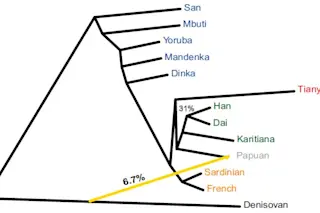Citation: Q Fu, M Meyer, XGao, U Stenzel, H A. Burbano, J Kelso, S PääboDNA analysis of an early modern human from Tianyuan Cave, ChinaPNAS 2013 ; published ahead of print January 22, 2013, doi:10.1073/pnas.1221359110 The above is a graph which illustrates phylogenetic relationships using the TreeMix package. It is from the paper I alluded to yesterday. The paper, DNA analysis of an early modern human from Tianyuan Cave, China, is open access, so everyone should be able to read it. Its mtDNA analysis shows that the Tianyuan sample, from the region of Beijing and dating to ~40,000 years B.P., is a basal clade in haplogroup B, which is common in eastern Eurasia and the New World. This is a satisfying result insofar as the understanding in relation to this haplogroup is that it diversified ~50,000 years B.P. There is very strong support in these data for the proposition that ...
An Oceanian mystery
Discover DNA analysis of early modern humans from Tianyuan Cave, revealing insights into haplogroup B and eastern Eurasia's ancestry.
More on Discover
Stay Curious
SubscribeTo The Magazine
Save up to 40% off the cover price when you subscribe to Discover magazine.
Subscribe













